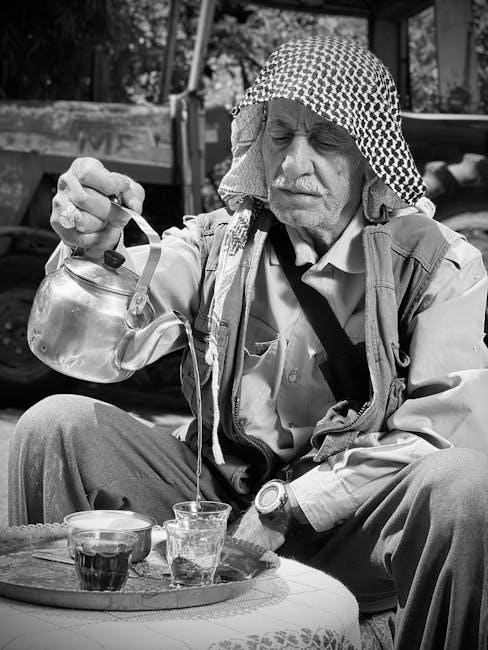“The Marrow of Tradition‚” a novel by Charles W. Chesnutt‚ explores the profound racial tensions and violence in the post-Civil War South‚ reflecting societal hierarchies and traditions.
Overview of the Novel
“The Marrow of Tradition” by Charles W. Chesnutt is a powerful exploration of racial tensions and societal hierarchies in the post-Civil War South. Set in the fictional town of Wellington‚ the novel delves into the aftermath of the violent Wellington Riot‚ mirroring real historical events like the Wilmington Insurrection. Through the intertwined lives of characters such as Dr. William Miller‚ a Black physician‚ and Olivia Carteret‚ a white aristocrat‚ Chesnutt examines themes of racial injustice‚ violence‚ and the enduring legacy of slavery. The novel vividly portrays the struggles of African Americans navigating a society resistant to change‚ offering a searing critique of systemic racism and its impact on individuals and communities.
Historical Context of the Book
“The Marrow of Tradition” is set against the backdrop of the post-Civil War era in the United States‚ a time marked by racial tension and the rise of Jim Crow laws. Inspired by the 1898 Wilmington Insurrection‚ the novel reflects the violent displacement of African Americans and the erosion of their rights during Reconstruction. Chesnutt critiques the resurgence of white supremacy and the systemic oppression faced by Black communities. The historical context underscores the novel’s exploration of racial violence‚ political corruption‚ and the struggle for equality‚ making it a poignant commentary on the legacy of slavery and segregation in America.
Significance of the Title
The title “The Marrow of Tradition” refers to the deep-rooted cultural and racial prejudices embedded in Southern society after the Civil War. “Marrow” symbolizes the core of these traditions‚ which perpetuate inequality and violence. Chesnutt uses this metaphor to expose how these entrenched beliefs obstruct progress and maintain white supremacy. The title highlights the novel’s central theme of confronting the legacy of slavery and racism‚ emphasizing that true change requires addressing the fundamental‚ ingrained issues within society. Through this title‚ Chesnutt underscores the enduring impact of historical injustices on contemporary life.

Author Background
Charles W. Chesnutt‚ a prominent African American writer‚ was born in 1858 and became a key figure in addressing racial issues in late 19th-century America through his works.

Charles W. Chesnutt’s Biography
Charles W. Chesnutt‚ a trailblazing African American writer‚ was born in 1858 in Cleveland‚ Ohio. He grew up in a family that valued education and social justice‚ which deeply influenced his writing. Chesnutt began his career as a teacher and later became a successful businessman‚ but his true passion lay in literature. His works‚ including “The Marrow of Tradition”‚ addressed racial inequalities and societal norms in the post-Civil War era. Chesnutt’s writings were groundbreaking‚ offering a powerful voice for African American experiences during a time of significant racial tension and change.
Chesnutt’s Contributions to African American Literature
Charles W. Chesnutt made significant contributions to African American literature‚ becoming one of the first Black writers to gain national recognition. His works‚ such as “The Marrow of Tradition”‚ explored racial identity‚ inequality‚ and the complexities of the post-Civil War South. Chesnutt’s use of dialect and nuanced character development challenged stereotypes and provided authentic portrayals of African American life. His writing advocating for social justice and equality paved the way for future generations of Black authors. Chesnutt’s legacy lies in his ability to address sensitive topics with clarity and depth‚ making his work foundational to the African American literary tradition.
Why Chesnutt Wrote “The Marrow of Tradition”
Charles W. Chesnutt wrote “The Marrow of Tradition” to address the profound racial injustices and violence prevalent in the post-Civil War South. He aimed to expose the harsh realities faced by African Americans‚ challenging the dominant narratives that ignored their struggles. By depicting the complexities of racial identity and societal hierarchies‚ Chesnutt sought to advocate for social justice and equality. His work was driven by a desire to give voice to the African American experience‚ counteract stereotypes‚ and promote understanding and change during a tumultuous era in American history.

Historical Setting
Set in the late 19th-century South‚ The Marrow of Tradition explores the tumultuous post-Civil War era‚ marked by Reconstruction‚ Jim Crow laws‚ racial violence‚ and economic struggles‚ shaping societal hierarchies and traditions.
The Post-Civil War Era in the United States
The post-Civil War era in the U.S. was marked by Reconstruction‚ a tumultuous period of social‚ political‚ and economic upheaval. The abolition of slavery led to freed African Americans seeking equality‚ but systemic racism and white supremacy persisted. Southern states enacted Jim Crow laws‚ enforcing segregation and disenfranchisement. Racial violence‚ including lynchings and riots‚ became common tools of intimidation. The novel The Marrow of Tradition vividly portrays this era‚ highlighting the Wilmington Insurrection of 1898 as a backdrop for its exploration of racial tensions and the unraveling of Reconstruction’s promises. This period shaped the nation’s identity‚ exposing deep-seated prejudices and societal divides.
Racial Tensions and Violence in the South
Racial tensions and violence in the South during the post-Civil War era were pervasive‚ fueled by deep-seated prejudices and resistance to Reconstruction. African Americans faced systemic oppression‚ including lynchings‚ beatings‚ and economic exploitation. The novel vividly depicts the Wilmington Insurrection of 1898‚ a violent coup that overthrew a biracial government‚ symbolizing the broader struggle for racial equality. Chesnutt’s portrayal of these events highlights the brutal realities of white supremacy and the resilience of African Americans in the face of unrelenting hostility. The novel serves as a powerful critique of racial violence and its enduring impact on American society.

Plot Summary

The novel centers on the fictional town of Wellington‚ set during the post-Civil War era‚ exploring racial tensions and violence through the lives of Dr. William Miller and his wife Janet‚ African Americans navigating a hostile society‚ and the Carterets‚ a white aristocratic family. The story intertwines their lives‚ highlighting the brutal realities of racism and the struggle for equality in the South.
Major Themes and Conflicts
The novel delves into themes of racism‚ violence‚ and social injustice‚ set against the backdrop of post-Civil War tensions. It explores the struggles of African Americans seeking equality and dignity in a hostile society. Central conflicts include racial discrimination‚ personal identity‚ and the clash between tradition and progress. The protagonist‚ Dr. William Miller‚ faces systemic racism and personal loss‚ while his wife‚ Janet‚ grapples with her mixed heritage. The novel also examines the moral decay of white aristocrats clinging to power‚ highlighting the devastating impact of prejudice on individuals and communities. These themes underscore the ongoing fight for justice and equality.
Key Plot Twists and Character Development
The novel’s pivotal moment is the Wilmington Insurrection of 1898‚ a violent overthrow of the biracial government‚ mirroring real events. Dr. William Miller‚ a Black physician‚ faces racial discrimination and personal tragedy‚ while his wife‚ Janet‚ struggles with her mixed heritage. The insurrection leads to a turning point in their lives‚ exposing the brutality of racial hatred. Through these events‚ Chesnutt crafts a gripping narrative of loss‚ resilience‚ and the enduring struggle for justice. The characters’ development highlights the human cost of systemic racism and the strength of those fighting for equality in a fractured society.
Main Characters
Dr. William Miller‚ a determined Black physician‚ and Janet‚ his strong-willed wife‚ navigate racial injustice. Sandy Campbell‚ a complex antagonist‚ embodies the era’s racial tensions‚ driving the plot’s conflict and character growth.
Protagonist and Antagonist Analysis
Dr. William Miller‚ the protagonist‚ is a determined Black physician striving for justice and equality in a racially divided society. His wife‚ Janet‚ equally resolute‚ stands as a symbol of resilience. Sandy Campbell‚ the antagonist‚ represents the entrenched racial prejudices of the time‚ embodying the oppressive traditions that perpetuate inequality; His actions drive the novel’s central conflicts‚ highlighting the deep-seated tensions between progress and tradition. Through their interactions‚ Chesnutt vividly portrays the struggle for racial justice‚ with Miller challenging systemic oppression and Campbell reinforcing it‚ creating a stark contrast that underscores the novel’s thematic depth and historical relevance.
Supporting Characters and Their Roles
Olivia Carteret‚ a former slave owner‚ embodies the lingering prejudices of the old South‚ while her daughter‚ Mildred‚ symbolizes the lost innocence of a bygone era. Mrs. Carteret‚ Olivia’s sister‚ represents moral ambiguity‚ struggling with her own complicity in racial injustice. Clara‚ Sandy Campbell’s wife‚ adds depth with her quiet resistance and inner conflict. Other characters‚ like the unnamed mob leader‚ serve as catalysts for violence‚ highlighting societal hatred. Together‚ these supporting roles enrich the narrative‚ exploring themes of racial conflict‚ moral complexity‚ and the struggle for justice in a fractured society. Their interactions drive the plot and deepen its emotional resonance.

Themes Explored
Racism‚ violence‚ and social injustice are central‚ exploring the deep-rooted prejudices of the post-Civil War South. Identity‚ family bonds‚ and the struggle for equality are also poignantly portrayed.
Racism and Prejudice in the South
“The Marrow of Tradition” vividly portrays the entrenched racism and prejudice in the post-Civil War South‚ highlighting the systemic oppression faced by African Americans. Chesnutt critiques the racial hierarchies perpetuated by white supremacists‚ illustrating how violence and discrimination were tools to maintain power. The novel exposes the hypocrisy of societal norms that justified segregation and brutality‚ while also depicting the resilience and resistance of Black communities. Through its unflinching portrayal‚ the book underscores the deep-seated racial tensions that shaped the era‚ offering a powerful commentary on the legacy of slavery and its enduring impact on American society.
Violence and Its Impact on Society
Violence in “The Marrow of Tradition” serves as a stark reminder of the brutal reality faced by African Americans in the post-Civil War South. Chesnutt vividly depicts racial violence‚ such as lynchings and riots‚ which were used to suppress Black progress and maintain white dominance. These acts of violence not only destroyed lives but also perpetuated fear and mistrust within communities. The novel illustrates how societal structures legitimized violence against marginalized groups‚ highlighting its devastating impact on individuals and the broader social fabric. Through this‚ Chesnutt condemns the systemic brutality that underpinned racial inequality in America.
Identity and Social Justice
In “The Marrow of Tradition‚” identity and social justice are central themes‚ as the novel explores the struggles of African Americans in a society deeply entrenched in racism. Chesnutt delves into the complexities of Black identity‚ highlighting the tension between assimilation and cultural preservation. The characters’ experiences reveal the systemic barriers erected to deny them equal rights and dignity. Through their stories‚ the novel advocates for social justice‚ challenging the moral hypocrisy of a nation that professed freedom but perpetuated inequality. Chesnutt’s portrayal of resilience and resistance underscores the enduring fight for racial equity and the pursuit of a just society.

Family and Community Ties
Family and community ties are vital in “The Marrow of Tradition‚” as they provide emotional support and resilience against racial oppression. Chesnutt portrays strong bonds within African American families‚ emphasizing their role in preserving cultural identity and fostering collective strength. The novel highlights how communities rally together to confront injustice‚ illustrating the importance of unity in the face of adversity. These ties are not only a source of comfort but also a form of resistance‚ enabling characters to navigate the challenges of a society deeply divided by race and inequality.

Literary Style and Techniques
Chesnutt’s vivid imagery and symbolism in “The Marrow of Tradition” highlight racial injustices‚ while his narrative structure blends fiction with historical truths‚ creating emotional depth and moral complexity.
Narrative Structure and Style
In “The Marrow of Tradition‚” Chesnutt employs a non-linear narrative structure‚ blending historical events with fictional accounts. His style is both realist and expressive‚ using vivid imagery to convey the brutality of racial violence. The novel alternates between scenes of domestic life and public turmoil‚ creating a layered exploration of societal tensions. Chesnutt’s prose is precise and evocative‚ balancing dramatic intensity with nuanced character development. The narrative voice shifts between perspectives‚ offering a multifaceted view of the conflict. This approach underscores the novel’s historical significance while maintaining its emotional and thematic depth‚ making it a powerful critique of racial injustice in the post-Civil War South.
Symbolism and Imagery in the Novel
Chesnutt masterfully employs symbolism and imagery to underscore the novel’s themes of race‚ violence‚ and societal division. Blood and violence symbolize the brutal legacy of slavery and racism‚ while fire and destruction represent both devastation and the potential for transformation. The color line is a recurring symbol‚ embodying the rigid racial segregation of the time. Natural imagery‚ such as storms and decay‚ reflects the turmoil and moral rot in the societal fabric. These elements create a vivid backdrop for exploring the psychological and emotional toll of racial oppression‚ making the novel a powerful exploration of America’s enduring racial divide.
Reception and Reviews
“The Marrow of Tradition” initially faced mixed reviews‚ with critics praising its powerful portrayal of racial tensions while others found its realism too harsh. Over time‚ it has been recognized as a significant work in African American literature‚ offering a searing critique of racism and violence in the post-Civil War South;
Initial Reception and Controversies
Upon its release‚ “The Marrow of Tradition” sparked intense debate due to its unflinching portrayal of racial violence and societal inequities. Critics praised the novel’s vivid storytelling but some found its graphic depictions of events like the Wilmington Riot too unsettling. The book faced controversy for its direct challenge to racial norms‚ leading to both acclaim and backlash. Chesnutt’s bold narrative style and refusal to romanticize the South earned him criticism from conservative reviewers but also solidified his reputation as a groundbreaking African American writer.
Modern Critical Analysis
Modern scholars praise “The Marrow of Tradition” for its unflinching examination of race‚ identity‚ and social justice. Critics highlight its exploration of systemic racism and the enduring impact of slavery; Chesnutt’s vivid portrayal of the Wilmington Riot and its aftermath is seen as a powerful critique of racial violence. Contemporary analysis also commends the novel’s nuanced character development and its challenge to racial stereotypes. The book is now recognized as a landmark in African American literature‚ offering timeless insights into the complexities of American society. Its themes resonate strongly in today’s conversations about inequality and justice.
Adaptations and Interpretations
“The Marrow of Tradition” has seen limited stage adaptations but remains a subject of deep scholarly interpretation. Its themes of race and justice continue to resonate strongly.
Stage and Screen Adaptations
Despite its literary acclaim‚ “The Marrow of Tradition” has seen limited stage and screen adaptations due to its complex themes and historical context. The novel’s intense exploration of racial violence and societal tensions presents challenges for visual interpretation. However‚ its powerful narrative has inspired scholarly discussions and partial dramatizations in academic settings. The lack of mainstream adaptations underscores the need for innovative approaches to bring Chesnutt’s poignant story to broader audiences‚ preserving its message of racial justice and historical reflection.

Study Guides and Resources
Study guides for “The Marrow of Tradition” are widely available online‚ offering summaries‚ analyses‚ and critical essays. These resources aid readers in understanding the novel’s themes and historical context.
Available Study Materials for the Novel
Various study materials for “The Marrow of Tradition” are accessible online‚ including PDF guides‚ essays‚ and summaries. These resources provide in-depth analyses of themes‚ characters‚ and historical context‚ aiding students and readers. They cover plot summaries‚ character analyses‚ and critical interpretations‚ offering insights into Chesnutt’s exploration of race and society. Additionally‚ discussion questions and essay prompts are available to enhance understanding and facilitate classroom discussions. These materials are invaluable for anyone seeking a deeper comprehension of the novel’s significance and literary merit. They are widely available through educational websites and online platforms.
PDF Version Availability
“The Marrow of Tradition” is available as a PDF online through various platforms‚ including educational websites‚ libraries‚ and eBook repositories for easy access and study.
Where to Find the PDF Online
The PDF version of “The Marrow of Tradition” can be accessed through various online platforms. Many websites offer free downloads‚ such as Google Books‚ Project Gutenberg‚ and ManyBooks. Additionally‚ university libraries and eBook repositories like JSTOR often provide access to the novel. Some platforms may require subscriptions or institutional access. Always verify the legitimacy of the source to ensure compliance with copyright laws. For convenience‚ readers can search directly on these platforms or use academic databases to locate the PDF version of the book.
Legal and Ethical Considerations
Accessing “The Marrow of Tradition” in PDF form requires adherence to copyright laws. The novel is in the public domain‚ making it legally available for free download. Ensure you use reputable sources like Google Books‚ Project Gutenberg‚ or ManyBooks to avoid pirated copies. Always respect intellectual property rights‚ even for public domain works. Ethically‚ acknowledge the author’s contribution when sharing or using the text. For institutional access‚ universities or libraries may offer legitimate downloads. Remember‚ fair use applies to education and personal reading. Choose legal and ethical sources to support literary preservation and access.
Contemporary Relevance
“The Marrow of Tradition” remains relevant today‚ offering insights into systemic racism and inequality‚ crucial for understanding historical roots of modern social issues and justice movements.
Why “The Marrow of Tradition” Matters Today
Charles W. Chesnutt’s “The Marrow of Tradition” remains a vital exploration of racial injustice and societal inequality‚ resonating deeply with modern discussions on systemic racism and social justice. Its vivid portrayal of violence‚ prejudice‚ and resilience in the post-Civil War South mirrors contemporary struggles‚ offering historical context to ongoing issues. The novel’s unflinching examination of human rights violations and the enduring impact of slavery underscores the importance of confronting the past to address present inequalities. As a literary masterpiece‚ it continues to educate and provoke‚ urging readers to reflect on the persistent challenges of race and identity in America today.
“The Marrow of Tradition” stands as a powerful narrative‚ exposing racial injustice and societal fractures‚ remaining a crucial exploration of America’s past and its enduring relevance today.
Final Thoughts on the Novel’s Impact
Charles W. Chesnutt’s “The Marrow of Tradition” remains a searing indictment of racial injustice‚ offering profound insights into America’s troubled past. Its vivid portrayal of the Wilmington Massacre and societal divisions underscores the enduring struggle for equality. The novel’s unflinching examination of violence‚ prejudice‚ and resilience continues to resonate‚ making it a vital work for understanding racial dynamics in America. Its impact lies in its ability to provoke reflection on the legacy of slavery and segregation‚ ensuring it remains a cornerstone of African American literature and a powerful tool for fostering dialogue about justice and equality.
